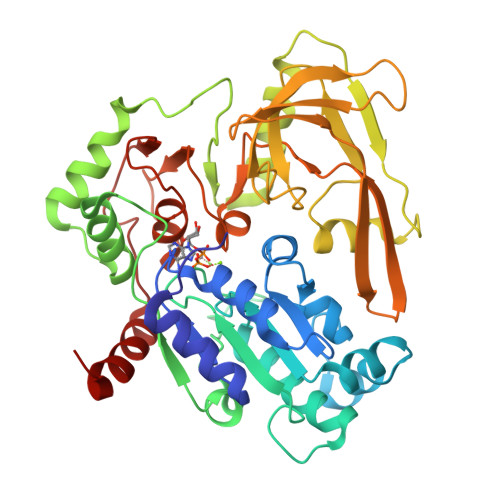Structural and functional analysis of the nucleotide and DNA binding activities of the human PIF1 helicase.
Dehghani-Tafti, S., Levdikov, V., Antson, A.A., Bax, B., Sanders, C.M.(2019) Nucleic Acids Res 47: 3208-3222
- PubMed: 30698796
- DOI: https://doi.org/10.1093/nar/gkz028
- Primary Citation of Related Structures:
6HPH, 6HPQ, 6HPT, 6HPU - PubMed Abstract:
Pif1 is a multifunctional helicase and DNA processing enzyme that has roles in genome stability. The enzyme is conserved in eukaryotes and also found in some prokaryotes. The functions of human PIF1 (hPIF1) are also critical for survival of certain tumour cell lines during replication stress, making it an important target for cancer therapy. Crystal structures of hPIF1 presented here explore structural events along the chemical reaction coordinate of ATP hydrolysis at an unprecedented level of detail. The structures for the apo as well as the ground and transition states reveal conformational adjustments in defined protein segments that can trigger larger domain movements required for helicase action. Comparisons with the structures of yeast and bacterial Pif1 reveal a conserved ssDNA binding channel in hPIF1 that we show is critical for single-stranded DNA binding during unwinding, but not the binding of G quadruplex DNA. Mutational analysis suggests that while the ssDNA-binding channel is important for helicase activity, it is not used in DNA annealing. Structural differences, in particular in the DNA strand separation wedge region, highlight significant evolutionary divergence of the human PIF1 protein from bacterial and yeast orthologues.
Organizational Affiliation:
Department of Oncology and Metabolism, Academic Unit of Molecular Oncology, University of Sheffield, Beech Hill Rd., Sheffield S10 2RX, UK.




















